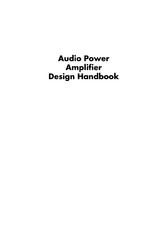Search and Find
Service
Contents
5
Synopsis
7
Preface
15
1 Introduction and general survey
17
The economic importance of power amplifiers
17
The study of amplifier design
19
Misinformation in audio
21
The performance requirements for amplifiers
38
Acronyms
43
2 History, architecture and negative feedback
46
A brief history of amplifiers
46
Amplifier architectures
47
Power amplifier classes
49
AC and DC coupled amplifiers
57
Negative feedback in power amplifiers
60
3 The general principles of power amplifiers
76
How a generic amplifier works
76
The advantages of convention
78
The eight distortions
79
The performance of a standard amplifier
83
Open-loop linearity and how to determine it
83
Direct o/l gain measurement
84
Using model amplifiers
86
The concept of the Blameless amplifier
87
4 The small signal stages
89
The role of the input stage
89
Distortion from the input stage
90
BJTs vs FETs for the input stage
91
Singleton input stage versus differential pair
92
The input stage distortion in isolation
92
Input stage balance
95
The joy of current-mirrors
96
Improving input-stage linearity
98
Radical methods of improving input linearity
99
Input stage cascode configurations
101
Input noise and how to reduce it
101
Offset and match: the DC precision issue
105
The input stage and the slew-rate
106
The voltage-amplifier stage
107
Measuring VAS distortion in isolation
108
VAS operation
109
VAS distortion
111
Linearising the VAS: active load techniques
111
VAS enhancements
113
The importance of voltage drive
115
The balanced VAS
116
The VAS and manipulating open-loop bandwidth
117
Manipulating open-loop bandwidth
120
5 The output stage I
122
Classes and devices
122
The distortions of the output
125
The emitter-follower output
128
The CFP output
130
Quasi-complementary outputs
135
Triple-based output configurations
137
Triple EF output stages
137
Distortion and its mechanisms
138
Large-signal distortion (Distortion 3a)
139
Crossover distortion (Distortion 3b)
155
Switching distortion (Distortion 3c)
169
Thermal distortion
169
Thermal distortion in a power amp IC
172
Selecting an output stage
173
Closing the loop: distortion in complete amplifiers
174
6 The output stage II
179
Distortion number 4: VAS loading distortion
179
Distortion number 5: rail decoupling distortion
181
Distortion number 6: induction distortion
184
Distortion number 7: NFB takeoff point distortion
186
Distortion number 8: capacitor distortion
188
Design example: a 50 W Class-B amplifier
191
7 Compensation, slew-rate, and stability
199
Frequency compensation in general
199
Dominant-pole compensation
200
Lag compensation
201
Including the output stage: inclusive Miller compensation
202
Nested feedback loops
203
Two-pole compensation
204
Output networks
206
Crosstalk in amplifier output inductors
219
Reactive loads and speaker simulation
225
Loudspeaker loads and output stages
230
Enhanced loudspeaker currents
236
Amplifier instability
238
Speed and slew-rate in audio amplifiers
240
8 Power supplies and PSRR
251
Power supply technologies
251
Design considerations for power supplies
254
9 Class-A power amplifiers
271
An introduction to class-A
271
Class-A configurations and efficiency
272
Output stages in Class-A
275
Quiescent current control systems
279
A novel quiescent current controller
281
A Class-A design
283
The trimodal amplifier
285
Load impedance and operating mode
287
Efficiency
288
On Trimodal biasing
293
Class-A/AB mode
294
Class-B mode
297
The mode-switching system
297
Thermal design
298
A complete Trimodal amplifier circuit
299
The power supply
302
The performance
302
10 Class-G power amplifiers
306
The principles of Class-G
306
Introducing series class-G
307
Efficiency of Class-G
309
Practicalities
312
The biasing requirements
312
The linearity issues of series Class-G
314
The static linearity
315
Practical Class-G design
318
Controlling small-signal distortion
318
The performance
322
Deriving a new kind of amplifier: Class-A + C
325
Adding two-pole compensation
327
Further variations on Class-G
329
11 FET output stages
330
The characteristics of power FETS
330
FET vs BJT output stages
331
IGBTs
332
Power FET output stages
334
Power FETs and bipolars: the linearity comparison
337
FETs in Class-A stages
337
12 Thermal compensation and thermal dynamics
341
Why quiescent conditions are critical
341
Accuracy required of thermal compensation
342
Basic thermal compensation
347
Assessing the bias errors
348
Thermal simulation
348
Modelling the EF output stage
350
Modelling the CFP output stage
358
The integrated absolute error criterion
360
Improved thermal compensation: the emitter-follower stage
361
Improved compensation for the CFP output stage
364
A better sensor position
365
A junction-temperature estimator
366
A junction estimator with dynamics
368
Variable-tempco bias generators
373
Thermal dynamics in reality
380
13 Amplifier and loudspeaker protection
386
Categories of amplifier protection
386
Overload protection
388
Catching diodes
399
DC-offset protection
400
Thermal protection
408
Powering auxiliary circuitry
410
14 Grounding and practical matters
412
Audio amplifier PCB design
412
Amplifier grounding
420
Ground loops: how they work and how to deal with them
421
Class I and Class II
428
Mechanical layout and design considerations
430
15 Testing and safety
434
Testing and fault-finding
434
Safety
436
Index
439
All prices incl. VAT











